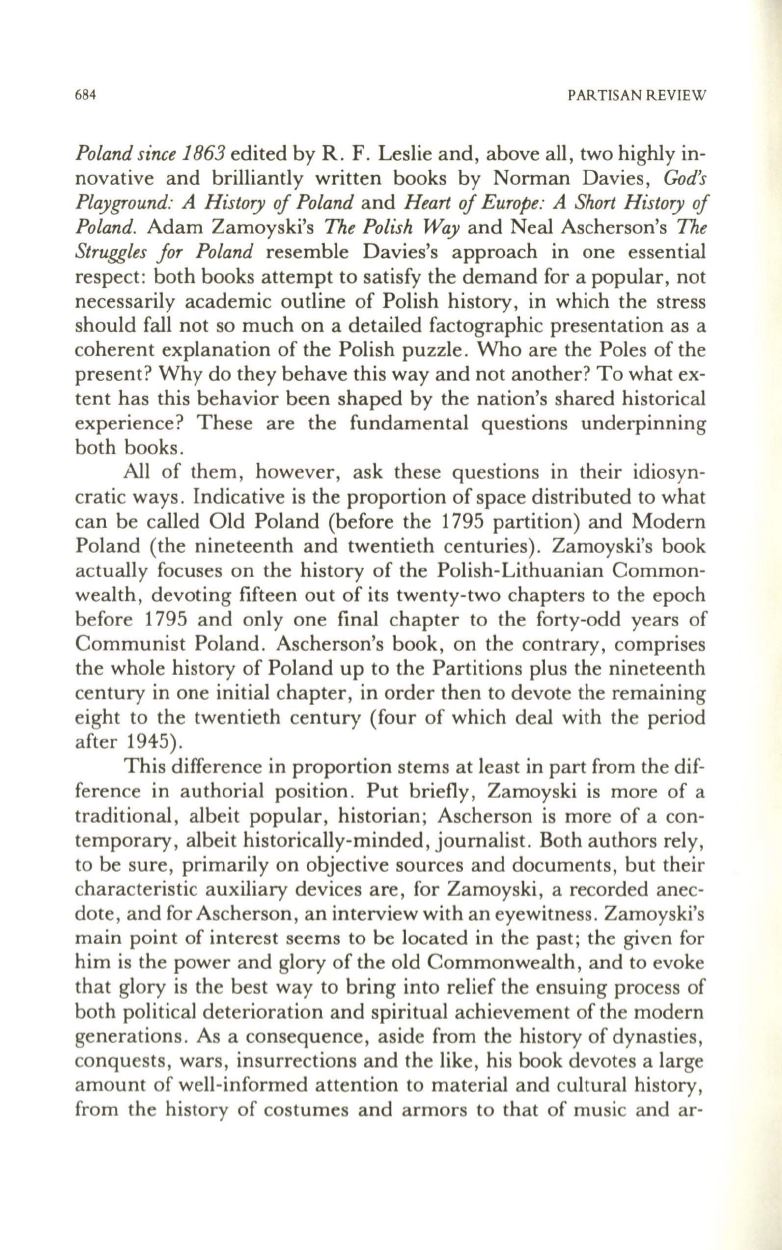
684
PARTISAN REVIEW
Poland since
1863 edited by R. F. Leslie and, above all, two highly in–
novative and brilliantly written books by Norman Davies,
God's
Playground: A History
of
Poland
and
Heart of Europe: A Short History
of
Poland.
Adam Zamoyski's
The Polish Way
and Neal Ascherson's
The
Struggles for Poland
resemble Davies's approach in one essential
respect: both books attempt to satisfy the demand for a popular, not
necessarily academic outline of Polish history, in which the stress
should fall not so much on a detailed factographic presentation as a
coherent explanation of the Polish puzzle. Who are the Poles of the
present? Why do they behave this way and not another? To what ex–
tent has this behavior been shaped by the nation's shared historical
experience? These are the fundamental questions underpinning
both books.
All of them, however, ask these questions in their idiosyn–
cratic ways. Indicative is the proportion of space distributed to what
can be called Old Poland (before the
1795
partition) and Modern
Poland (the nineteenth and twentieth centuries). Zamoyski's book
actually focuses on the history of the Polish-Lithuanian Common–
wealth, devoting fifteen out of its twenty-two chapters to the epoch
before
1795
and only one final chapter to the forty-odd years of
Communist Poland. Ascherson's book, on the contrary, comprises
the whole history of Poland up to the Partitions plus the nineteenth
century in one initial chapter, in order then to devote the remaining
eight to the twentieth century (four of which deal with the period
after
1945) .
This difference in proportion stems at least in part from the dif–
ference in authorial position. Put briefly, Zamoyski is more of a
traditional, albeit popular, historian; Ascherson is more of a con–
temporary, albeit historically-minded, journalist. Both authors rely,
to be sure , primarily on objective sources and documents, but their
characteristic auxiliary devices are , for Zamoyski, a recorded anec–
dote, and for Ascherson, an interview with an eyewitness . Zamoyski's
main point of interest seems to be located in the past; the given for
him is the power and glory of the old Commonwealth, and to evoke
that glory is the best way to bring into relief the ensuing process of
both political deterioration and spiritual achievement of the modern
generations . As a consequence, aside from the history of dynasties,
conquests , wars, insurrections and the like, his book devotes a large
amount of well-informed attention to material and cultural history,
from the history of costumes and armors to that of music and ar-


